List of Contents
What is the Spatial Transcriptomics Market Size?
The global spatial transcriptomics market size is accounted at USD 469.36 million in 2025 and is predicted to increase from USD 536.71 million in 2026 to approximately USD 1,569.03 million by 2034, expanding at a CAGR of 14.35% from 2025 to 2034. The market is experiencing significant growth because of the increasing demand for high-resolution molecular profiling in complex tissues. Additionally, a greater focus on cancer research, drug discovery, and developmental biology accelerated this market's growth. Advancements in single-cell analysis and spatial genomics technologies are expected to support the continued expansion of the market in the coming years.
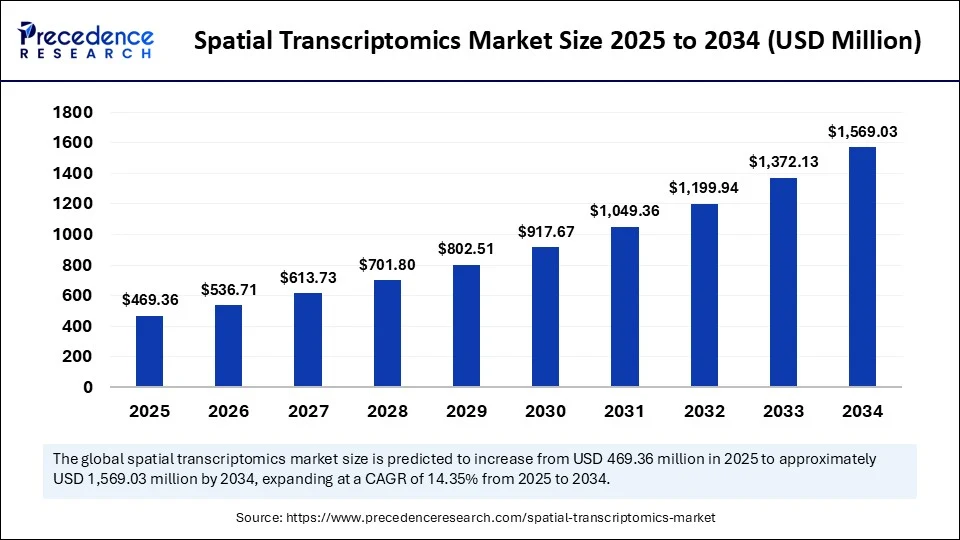
Spatial Transcriptomics Market Key Takeaways
- North America dominated the spatial transcriptomics market with the largest share of 48% in 2024.
- Asia Pacific is expected to grow at the fastest CAGR from 2025 to 2034.
- By technology, the sequencing-based spatial transcriptomics segment captured the biggest market share of 52% in 2024.
- By technology, the imaging-based spatial transcriptomics segment is expected to grow at a significant CAGR over the projected period.
- By product & solution, the consumables segment contributed the largest market share of 47% in 2024.
- By product & solution, the software & services segment is anticipated to grow at the highest CAGR from 2025 to 2034.
- By sample type, the fresh frozen tissues segment held the biggest market share of 44% in 2024.
- By sample type, the FFPE (Formalin-Fixed Paraffin-Embedded) tissues segment is likely to expand at a significant CAGR from 2025 to 2034.
- By workflow stage, the imaging/sequencing segment dominated the market with the highest market share of 40% in 2024.
- By workflow stage, the data analysis & interpretation segment is experiencing rapid growth during the forecast period.
- By application, the oncology segment generated the major market share of 57% in 2024.
- By application, the immunology segment is expected to grow at a significant CAGR from 2025 to 2034.
- By end user, the academic & research institutes segment held a significant market share of 49% in 2024.
- By end user, the pharmaceutical & biotech companies segment is expected to grow at a remarkable CAGR from 2025 to 2034.
Market Overview
Spatial transcriptomics is a cutting-edge omics technique that allows for the measurement and visualization of gene expression within the spatial context of tissue architecture. Unlike traditional RNA-sequencing, which loses positional data, spatial transcriptomics retains this information, enabling researchers to pinpoint where specific gene activities occur in a tissue section. This technology is transforming fields such as cancer biology, neuroscience, developmental biology, and pathology by combining histological visualization with transcriptomic data. The market is growing due to the increased adoption of spatial transcriptomics in drug discovery and development and advances in sequencing technologies. The rising demand for high-resolution single-cell analysis, combined with the increasing prevalence of complex diseases such as cancer and neurological disorders, further supports market growth.
How Can AI Impact the Spatial Transcriptomics Market?
Artificial intelligence (AI) is transforming the market for spatial transcriptomics by enabling more efficient data analysis, improving spatial resolution, and facilitating integrated analysis of multi-omics datasets. AI algorithms can streamline large-scale data processing, identify complex patterns, and enhance predictions of gene expression, resulting in better insights into disease mechanisms and potential therapeutic targets. AI manages the computational demands of multidimensional data, detects subtle patterns and biomarkers that might be overlooked by traditional methods, and allows researchers to compare gene expression across different conditions, technologies, and developmental stages. Overall, AI drives market expansion
What are the Key Trends in the Spatial Transcriptomics Market?
- Rising Prevalence of Chronic Diseases: The growing incidence of diseases such as cancer and neurological disorders is fueling the need for advanced diagnostic and therapeutic approaches, with spatial transcriptomics providing valuable insights.
- Increasing Demand for Single-Cell Analysis:Spatial transcriptomics offers higher resolution than traditional single-cell RNA sequencing by preserving spatial context. The ability to integrate spatial transcriptomics with other omics technologies, such as genomics and proteomics, enhances its capabilities and drives its adoption.
- Growing Applications in Drug Discovery:Spatial transcriptomics is increasingly being utilized in drug discovery and development to identify novel drug targets, evaluate drug efficacy, and understand drug resistance, as well as for biomarker identification and personalized medicine.
- Increased Adoption in Research and Drug Discovery:Spatial transcriptomics is becoming increasingly important in drug discovery, biomarker identification, and personalized medicine. Increased public and private funding for research in areas like spatial genomics and transcriptomics is contributing to market expansion.
- Advancements in Sequencing Technologies:Innovations in sequencing platforms and computational tools have improved the resolution, sensitivity, and throughput of spatial transcriptomics. Ongoing advancements in technologies, including enhanced imaging, higher throughput capabilities, and improved resolution, are driving market growth.
Market Scope
| Report Coverage | Details |
| Market Size by 2034 | USD 1,569.03 Million |
| Market Size in 2026 | USD 536.71 Million |
| Market Size in 2025 | USD 469.36 Million |
| Market Growth Rate from 2025 to 2034 | CAGR of 14.35% |
| Dominating Region | North America |
| Fastest Growing Region | Asia Pacific |
| Base Year | 2024 |
| Forecast Period | 2025 to 2034 |
| Segments Covered | Technology, Product & Solution, Sample Type, Workflow Stage, Application, End User, and Region |
| Regions Covered | North America, Europe, Asia-Pacific, Latin America, and Middle East & Africa |
Market Dynamics
Drivers
Growing Need for High-Resolution Spatial Analysis Tools
The primary driver of the spatial transcriptomics market is the growing need for high-resolution spatial analysis tools in drug development and biological research, especially for understanding complex diseases like cancer and neurological disorders. This demand is supported by the development of advanced bioinformatics and sequencing technologies, as well as a focus on personalized medicine. This technology enables researchers to understand how drugs affect different tissues at a molecular level, facilitating the prediction of drug efficacy and the identification of potential resistance mechanisms, thereby refining drug development strategies. The ongoing advancements in bioinformatics tools, sequencing technologies, and novel spatial analysis methods are also driving market growth.
Restraint
High Cost of Equipment and Related Operational Expenses
The main constraint in this market is the high cost of equipment and related operational expenses. This includes the cost of specialized instruments, infrastructure, and skilled personnel required to operate and interpret the generated data. Spatial transcriptomics technologies, including their instruments and reagents, require significant capital investment. Additionally, establishing and maintaining the required infrastructure, such as computational facilities and trained staff, adds to overall costs. The large and complex datasets produced demand specialized bioinformatics tools and expertise for analysis and interpretation.
Opportunity
Expanding Use of Spatial Omics
The key future opportunity for the spatial transcriptomics market lies in the expanding use of spatial omics for biomarker discovery and clinical applications, especially in fields like cancer, neuroscience, and immunology. This involves leveraging spatial transcriptomics to understand disease mechanisms at the cellular level, leading to more targeted and effective diagnostics and treatments. By preserving spatial information, this technology helps reveal the intricate interactions between cells and genes within tissues, offering a more comprehensive view of biological systems and developmental biology, where spatial organization is crucial. Spatial omics techniques are moving beyond basic research into translational and clinical settings, paving the way for innovative diagnostic and therapeutic approaches.
Segment Insight
Technology Insights
What Made Sequencing-Based Spatial Transcriptomics the Dominant Segment in the Spatial Transcriptomics Market in 2024?
The sequencing-based spatial transcriptomics segment dominated the market with a major share in 2024. The dominance of sequencing-based spatial transcriptomics stems from their ability to provide high-resolution, unbiased whole-transcriptome analysis of tissues. By combining next-generation sequencing with spatial information, this method enables the mapping of gene expression patterns across entire tissue sections, providing a comprehensive view of cellular organization and function. Additionally, Visium benefits from the widespread use of next-generation sequencing as a standard tool in molecular biology research. 10x Genomics offers user-friendly software, such as Space Ranger and Loupe Browser, which facilitates data analysis and visualization.
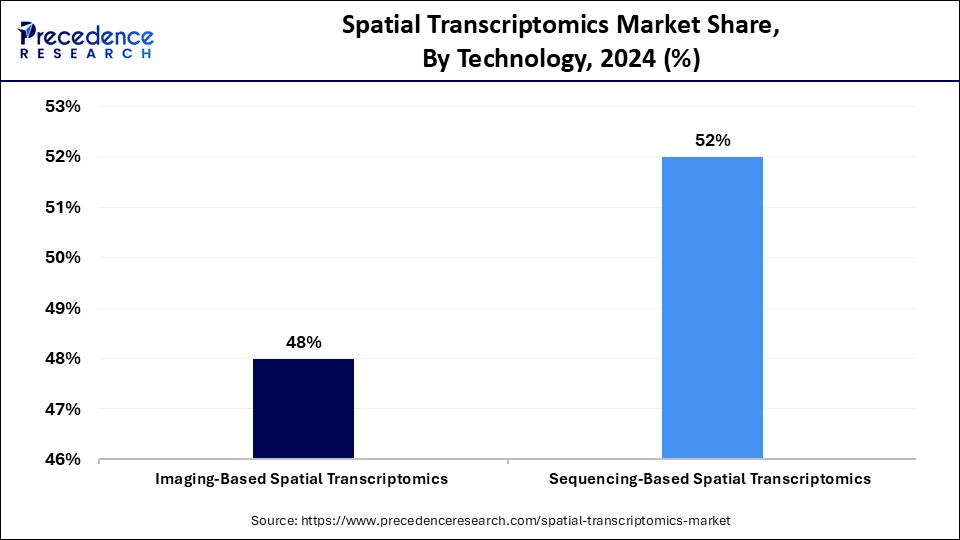
The imaging-based spatial transcriptomics is expected to experience rapid growth during the forecast period. This is primarily because of their ability to deliver high-resolution, spatially resolved gene expression data. This technology enables researchers to visualize and quantify multiple gene expressions within individual cells in their native tissue context, providing insights into complex biological processes and disease mechanisms. Its high-resolution, multiplexed approach allows for detailed spatial analysis at the single-cell level. By mapping gene expression within tissues, researchers can better understand cell-cell interactions, tissue organization, and developmental processes
Product & Solution Insights
How Does the Consumables Segment Lead the Spatial Transcriptomics Market in 2024?
The consumables segment led the market in 2024. This is mainly because of their widespread use in various research applications and frequent purchases. The dominance of the segment also stems from the essential role of consumables, such as reagents, kits, and specialized chemicals, in enabling accurate spatial analysis. Furthermore, the recurring need for consumables to operate and maintain instruments sustains a steady revenue stream. The demand for specific, advanced consumables for new instruments further stimulates growth in this segment.
The software & services segment is expected to grow at the highest CAGR in the upcoming period. The growth of the segment is driven by the vital role of software and services in analyzing the complex data generated by spatial transcriptomics technologies. They provide essential tools for data processing, visualization, and interpretation, which are crucial for extracting meaningful biological insights from large datasets. The integration of AI and machine learning into these platforms enhances the analysis of complex spatial gene expression patterns. As the complexity of spatial omics data increases, so does the need for advanced bioinformatics solutions, further accelerating growth in this segment.
Sample Type Insights
Why Did the Fresh Frozen Tissues Segment Become Dominant in the Spatial Transcriptomics Market in 2024?
The fresh frozen tissues segment dominated the market in 2024. This is primarily due to their ability to preserve tissue with intact morphology, proteins, DNA, and RNA, which are crucial for accurate molecular analysis. Fresh frozen tissues offer better permeabilization conditions for reagents used in spatial transcriptomics experiments, leading to higher-quality data. They maintain tissue structure, allowing for precise spatial mapping of gene expression within the tissue context. Many clinical research and diagnostic applications require the preservation of tissue integrity, making fresh frozen tissues the preferred choice. Leading companies, such as 10x Genomics and Akoya Biosciences, offer solutions specifically designed for fresh-frozen tissues, further accelerating their adoption.
The FFPE (Formalin-Fixed Paraffin-Embedded) tissues segment is likely to grow at the fastest CAGR during the projection period. This is primarily due to their widespread availability in pathology archives, preservation of tissue morphology, and advancements in compatibility with spatial transcriptomics technologies. These advancements, along with the increasing prevalence of cancer and other chronic diseases, are driving the demand for FFPE tissues in research and diagnostics to correlate gene expression data with specific cell types and tissue structures. Utilizing FFPE tissues eliminates the need for fresh frozen samples, which are more expensive and require specialized handling and storage.
Workflow Stage Insights
What Made Imaging/Sequencing the Dominant Segment in the Spatial Transcriptomics Market in 2024?
The imaging/sequencing segment dominated the market in 2024. This is mainly due to its high resolution, scalability, and suitability for hypothesis generation and disease research. Sequencing-based methods, such as those used in Slide-seq and sci-Space, provide high-resolution mapping of gene expression across tissue sections, enabling researchers to visualize gene activity at cellular and even subcellular levels. This high resolution, combined with the ability to analyze large tissue areas, makes sequencing ideal for both hypothesis generation and large-scale studies. These methods are well-suited for exploratory research, helping researchers identify novel gene expression patterns and potential biomarkers. This is essential for understanding complex biological processes and finding targets for drug development.
The data analysis & interpretation segment is expected to expand at the fastest rate in the market because of the increasing complexity of data and the need for advanced computational tools to extract meaningful biological insights. Analyzing these datasets to identify cell types, gene expression patterns, and their spatial relationships is a significant challenge that boosts the demand for specialized data analysis solutions. There is continuous development of new bioinformatics pipelines, algorithms, and software tools specifically designed for the analysis of spatial transcriptomics data. These advancements enable researchers to perform spatial clustering, differential expression analysis, and spatial network analysis with greater efficiency and accuracy.
Application Insights
Why Did the Oncology Segment Dominate the Spatial Transcriptomics Market in 2024?
The oncology segment maintained the dominant position in the market in 2024. This is mainly due to the vital role of spatial transcriptomics in understanding tumor microenvironments, identifying cell-to-cell interactions, and developing targeted therapies. By pinpointing specific genes and pathways involved in tumor development and progression, spatial transcriptomics helps identify novel drug targets for cancer treatment. Spatial transcriptomics data can also be used to predict how a tumor will respond to certain therapies, such as immunotherapy, by analyzing the composition and spatial arrangement of immune cells within the tumor to understand the complex interplay among cancer cells, immune cells, and other components within the tumor microenvironment.
The immunology segment is expected to experience the fastest growth during the forecast period. The segment's dominance stems from its key role in understanding and treating autoimmune diseases, infectious diseases, and cancer. Immunological diseases, such as autoimmune disorders and infections, are characterized by intricate cellular interactions and spatial arrangements. Spatial transcriptomics allows researchers to study gene expression within tissue architecture, revealing how different cell types interact and contribute to disease processes. This is especially valuable in immunology, where understanding the complex interplay of immune cells is crucial for developing targeted and more personalized immunotherapies.
End User Insights
How Does the Academic & Research Institutes Segment Lead the Spatial Transcriptomics Market in 2024?
The academic & research institutes segment led the market in 2024. This is mainly due to their important role in fundamental biological research, drug discovery, and biomarker identification. These institutions are at the forefront of developing and applying spatial transcriptomics technologies to understand complex biological processes and diseases, driving significant advancements. They play a vital role in identifying potential drug targets and understanding how drugs interact with tissues at a spatial level. This is crucial for developing more effective, targeted therapies and for early diagnosis and prognosis biomarkers.
The pharmaceutical & biotech companies segment is likely to experience the fastest growth in the upcoming period. This is primarily due to their critical role in drug discovery, development, and the advancement of personalized medicine. These companies heavily utilize spatial transcriptomics to gain a deeper understanding of biological processes, better enabling the identification of new drug targets, enhancing drug efficacy, and developing targeted therapies. The rising prevalence of chronic diseases is driving the demand for faster and more efficient drug development, further increasing the adoption of spatial transcriptomics in the industry. Pharmaceutical companies are increasing their investments in spatial transcriptomics R&D to stay competitive in drug discovery and development.
Regional Analysis
U.S. Spatial Transcriptomics Market Size and Growth 2025 to 2034
The U.S. spatial transcriptomics market size is exhibited at USD 157.70 million in 2025 and is projected to be worth around USD 536.49 million by 2034, growing at a CAGR of 14.55% from 2025 to 2034.
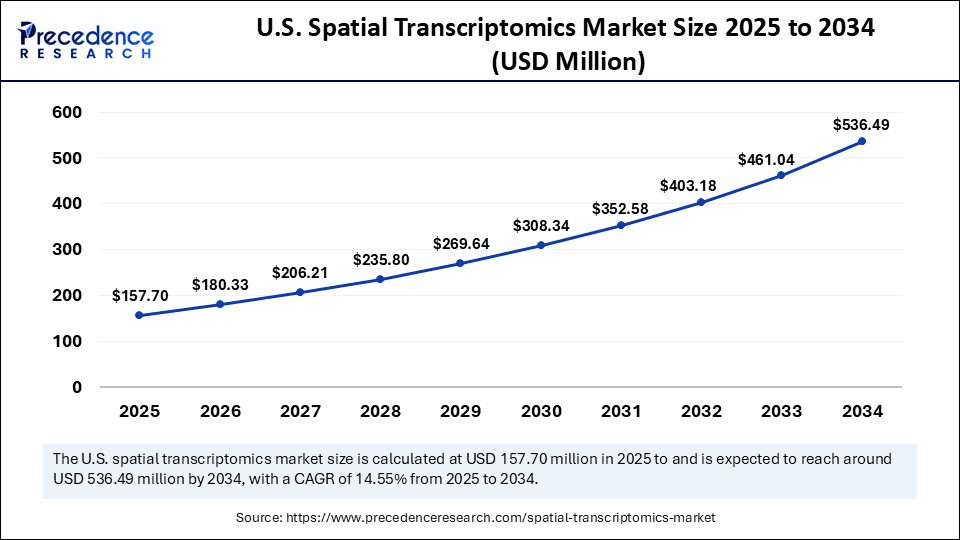
What Made North America the Dominant Region in the Spatial Transcriptomics Market in 2024?
North America dominated the spatial transcriptomics market with the largest share in 2024. This is primarily due to its robust research infrastructure, substantial investments in research and development, and a strong emphasis on personalized medicine. The increasing incidence of cancer and other diseases, such as metabolic, autoimmune, and inflammatory disorders, drives the need for advanced diagnostic and therapeutic approaches that spatial transcriptomics can provide for diagnostics, drug discovery, and personalized medicine. The region also benefits from many established spatial biology companies, such as 10x Genomics, Akoya Biosciences, and Bruker Corp., which are at the forefront of developing and commercializing spatial transcriptomics technologies. Thus, they have attained a leading position in the global market.
U.S. Spatial Transcriptomics Market Trends
The U.S. is a major contributor to the market within North America, driven by increased investments from both public and private sectors in R&D and the presence of leading biotechnology and pharmaceutical companies. There is a high demand for personalized medicine and an in-depth understanding of complex diseases, such as cancer, leading to the development and adoption of sophisticated spatial technologies within academic institutions, biotech firms, and clinical settings, along with strategic collaborations and government initiatives.
In January 2024, a U.S.-based Akoya Biosciences, Inc. announced that it had entered into a license and distribution agreement with Thermo Fisher Scientific, Inc. The agreement enables Akoya to market the combination of Akoya's spatial biology solutions, including its PhenoImager systems and PhenoCode reagents, with the Thermo Fisher ViewRNA in Situ Hybridization Assays for the detection of protein and RNA biomarkers in defining cell phenotypes and cell states in tissue samples.
(Source: https://investors.akoyabio.com)
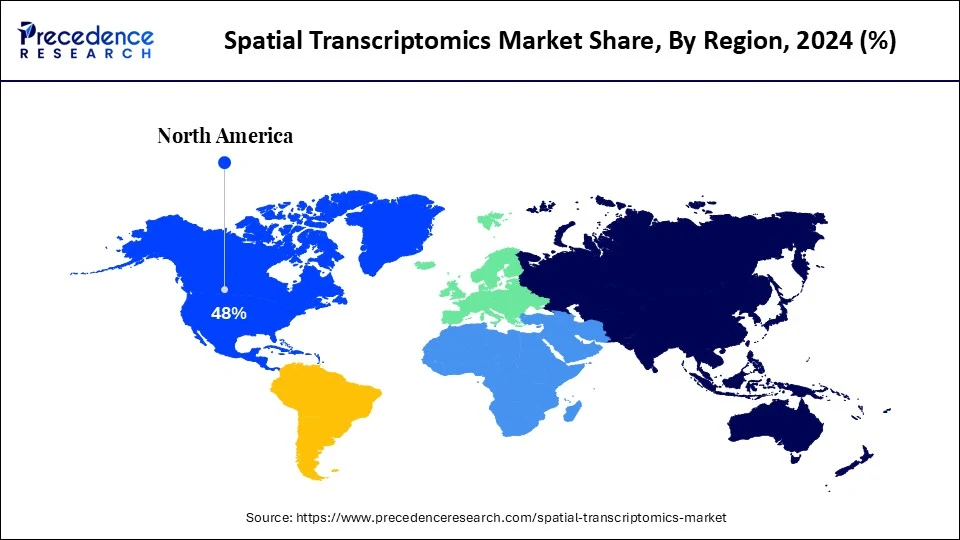
What Makes Asia Pacific the Fastest-Growing Region in the Spatial Transcriptomics Market?
Asia Pacific is expected to experience the fastest growth in the coming years due to several factors, including increased investments in life sciences research, a growing focus on precision medicine, and government initiatives that support biotechnology advancements. Countries like China, India, and Japan are significantly increasing their investments in biotechnology and life sciences research, including genomics and transcriptomics. National precision medicine programs in China are driving demand for spatial transcriptomics technologies as part of efforts to personalize healthcare. Governments in the region are actively promoting research and development in life sciences through various initiatives and funding opportunities, accelerating adoption.
China Spatial Transcriptomics Market Trends
China plays a major role in the market. This is mainly due to the increasing government funding for R&D and innovation in technology. Driven by healthcare initiatives like Made in China 2025 and increasing investments in clinical research and drug discovery, the country is witnessing a rise in demand for spatial transcriptomics tools and platforms. Leading Chinese companies, such as BGI Group and Novogene Co., Ltd., are actively integrating these technologies into various applications, including clinical research and drug discovery, thereby enhancing their market presence.
Why is Europe Considered a Notable Region in the Spatial Transcriptomics Market?
Europe is expected to grow at a notable rate in the upcoming period, primarily driven by a robust genomics research infrastructure, the increasing adoption of advanced technologies, and strategic investments in the life sciences. Europe boasts a well-established network of research institutions, universities, and biotech companies focused on genomics and related fields. This provides a solid foundation for developing and adopting spatial transcriptomics technologies. Continuous advancements in sequencing technologies, including next-generation sequencing (NGS), and the development of new biochemical and genomic tools are creating opportunities to understand disease mechanisms and identify potential drug targets.
UK Spatial Transcriptomics Market Trends
In the UK, spatial transcriptomics is gaining momentum as researchers and clinicians increasingly use AI‑driven bioinformatics tools to analyze spatial gene‑expression data at unprecedented resolution. There is a rapid shift toward multi‑omics integration, combining spatial transcriptomics with proteomics and metabolomics to get a more holistic picture of tissue biology. Meanwhile, innovations in high-throughput platforms and reagent kits are making spatial transcriptomics more accessible and scalable for a wider range of applications, including disease research and drug development.
In November 2024, Oxford Nanopore announced a partnership with the UK government to advance genomics-based healthcare innovation in the UK. In August 2024, the UK secured �400 million to support clinical trials that significantly improve patient access to state-of-the-art treatments. Such initiatives also contribute to market growth.
What Opportunities Exist in the Latin American Spatial Transcriptomics Market?
There is significant potential for market expansion in Latin America. This is mainly due to increasing research funding, advancements in personalized medicine, and the development of new biotech ecosystems. Regional collaboration initiatives and efforts to build translational capabilities are fueling this growth. Countries like Brazil, Mexico, and Argentina actively participate in international research networks. Initiatives like the Ibero-American Research Area aim to foster collaboration between regional countries and Spain, boosting research and innovation, and developing biotech industries, which creates opportunities for advancements in spatial transcriptomics.
Brazil Spatial Transcriptomics Market Trends
Brazil is the major contributor to the Latin American spatial transcriptomics market. This is mainly due to its strong biotechnology research ecosystem, significant public funding for genomics, and established academic institutions that are increasingly acquiring spatial omics capabilities. Rising launches of innovative products by local companies, technological advancements, and R&D funding also support market growth.
Argentina Spatial Transcriptomics Market Trends
In Argentina, the market is gaining traction as researchers increasingly integrate AI‑powered bioinformatics tools to analyze complex spatial gene-expression data. There is a growing focus on multi-omics approaches, combining spatial transcriptomics with other data types like proteomics to deepen insights into tissue biology. The national genomics initiatives and large-scale AI data center projects propel the country's growth in the spatial transcriptomics market. Increasing demand for precision medicine and investments in cancer research further drive the market.
What Factors Contribute to the Spatial Transcriptomics Market in the Middle East & Africa?
The market in the Middle East & Africa is expected to grow due to increased research funding, especially in areas such as drug discovery and personalized medicine. This growth is supported by a rising awareness of the potential of spatial transcriptomics to understand complex diseases and improve healthcare outcomes. Although specific government initiatives directly targeting spatial transcriptomics in MEA are less prominent, broader trends of increased research funding and biotech development are promoting adoption.
Saudi Arabia Spatial Transcriptomics Market Trends
In Saudi Arabia, the market is being driven by strong public sector support for multi-omics research, especially through national genomics initiatives that integrate spatial transcriptomics with proteomics and other molecular data. Software platforms and bioinformatics tools are gaining traction faster than hardware, as local researchers increasingly rely on AI-driven analysis to decode complex spatial gene expression patterns. Meanwhile, rising investments in biomedical research infrastructure, backed by universities and government bodies, are improving accessibility to spatial omics for precision medicine and disease profiling.
Spatial Transcriptomics Market Companies
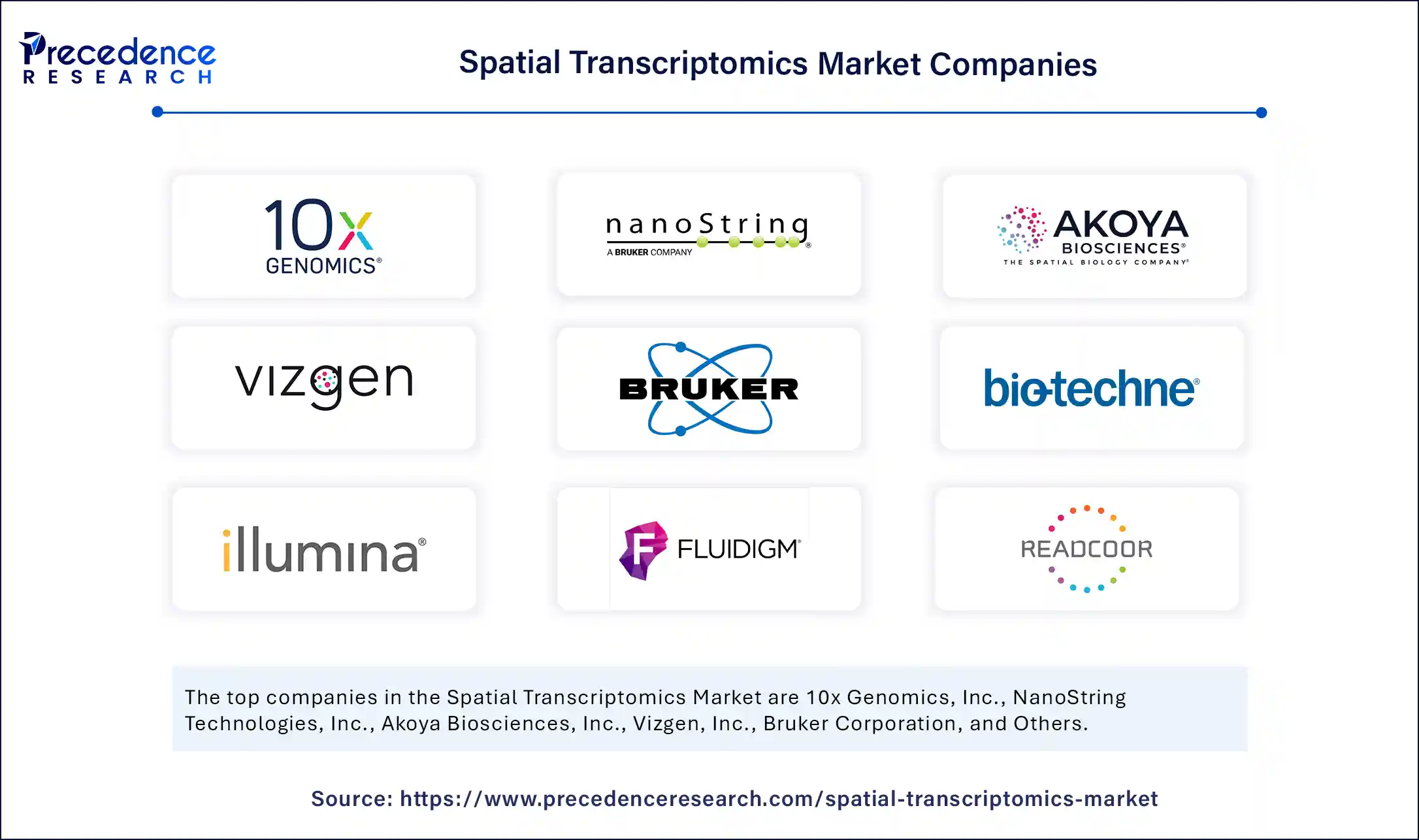
- 10x Genomics, Inc.
- NanoString Technologies, Inc.
- Akoya Biosciences, Inc.
- Vizgen, Inc.
- Bruker Corporation
- Bio-Techne Corporation (Advanced Cell Diagnostics)
- Illumina, Inc.
- Fluidigm Corporation
- ReadCoor, Inc
- CARTANA AB
- Dovetail Genomics
- Resolve Biosciences
- Molecular Cartography
- Spatial Genomics, Inc.
- Pixelgen Technologies AB
- Veranome Biosystems
- ACD Bio (Advanced Cell Diagnostics)
- NuProbe Inc.
- OriGene Technologies, Inc.
- Ultivue, Inc.
Recent Developments
- In February 2025, Illumina, Inc. launched a new spatial technology program that will enable researchers to map complex tissues and understand cellular behavior at an unprecedented scale. Powered by Illumina sequencers and a new multimodal analysis platform, this technology offers unbiased whole-transcriptome profiling with cellular resolution and high sensitivity. These features are expected to expand spatial research and unlock new applications and experiments that were previously impossible. (Source:https://www.illumina.com)
- In February 2025, Bruker Corporation announced significant advancements in spatial biology, including the CosMx Whole Transcriptome Panel, an improved engine to support CellScape� for spatial proteomics, an expansion to 1000-plex protein assay on GeoMx DSP, and the launch of PaintScape�, a revolutionary platform allowing direct visualization of the 3D genome. These innovations reinforce Bruker's dedication to advancing spatial biology with leading, innovative platforms. (Source: https://ir.bruker.com)
- In May 2024, Bruker Corporation announced that it had completed its asset acquisition of NanoString Technologies, Inc.'s spatial transcriptomics and gene expression analysis business. Under this deal, Bruker acquired nearly all assets and rights, including the nCounter, GeoMx, CosMx�, and AtoMx� product lines, which are important for scientific and medical research, as stated by President Dr. Mark R. Munch.(Source: https://ir.bruker.com)
- In April 2024, Vizgen, Inc. introduced the MERSCOPE Ultra Platform and MERFISH 2.0 chemistry. This system is a powerful, high-plex in situ spatial multiomic analysis platform, providing optimal imaging area and throughput capabilities in spatial transcriptomics imaging. The system is the only spatial platform to offer two different-sized flow cells, enabling users to adjust reagent consumption based on the area imaged.(Source: https://vizgen.com)
- In March 2024, 10x Genomics, Inc., announced the commercial launch of its Visium HD Spatial Gene Expression product. This assay allows researchers to compare Visium data (left) and Visium HD data (right) in FFPE human colorectal cancer, providing whole transcriptome data from FFPE tissue sections at single-cell resolution, significantly impacting scientific research. (Source:https://www.prnewswire.com)
Segments Covered in the Report
By Technology
- Imaging-Based Spatial Transcriptomics
- Fluorescence In Situ Hybridization (FISH)
- Multiplexed Error-Robust FISH (MERFISH)
- Sequential FISH (seqFISH)
- In Situ Sequencing (ISS)
- Others
- Sequencing-Based Spatial Transcriptomics
- Slide-Seq
- 10x Genomics Visium
- High-Definition Spatial Transcriptomics (HDST)
- Stereo-seq
- Others
By Product & Solution
- Instruments
- Consumables
- Slides & Reagents
- Sample Prep Kits
- Software & Services
- Data Analysis & Visualization Tools
- Cloud Storage & Integration Platforms
- Custom Spatial Profiling Services
- Others
By Sample Type
- FFPE (Formalin-Fixed Paraffin-Embedded) Tissues
- Fresh Frozen Tissues
- Organoids & Cell Cultures
- Others (e.g., Biopsy Punches, Cryosections)
By Workflow Stage
- Sample Preparation
- Spatial Barcoding
- Imaging/Sequencing
- Data Analysis & Interpretation
By Application
- Oncology
- Tumor Microenvironment Analysis
- Cancer Biomarker Discovery
- Neuroscience
- Developmental Biology
- Immunology
- Drug Discovery & Toxicology
- Others (e.g., Cardiovascular Research, Infectious Diseases)
By End User
- Academic & Research Institutes
- Pharmaceutical & Biotechnology Companies
- Contract Research Organizations (CROs)
- Hospitals & Diagnostic Centers
- Others (e.g., Government Labs, Pathology Labs)
By Region
- North America
- Europe
- Asia-Pacific
- Latin America
- Middle East & Africa
For inquiries regarding discounts, bulk purchases, or customization requests, please contact us at sales@precedenceresearch.com
Frequently Asked Questions
Ask For Sample
No cookie-cutter, only authentic analysis – take the 1st step to become a Precedence Research client



